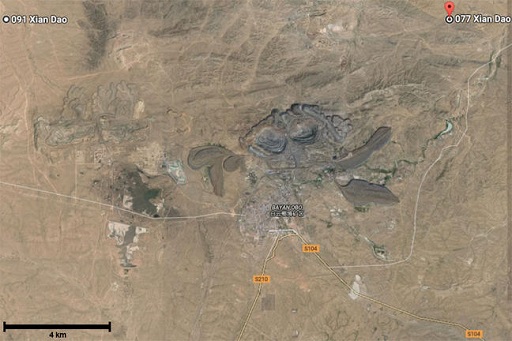4.7 Extraction and processing
One of the main pollutant issues with REE is that they are often found with radioactive elements, such as uranium and thorium. In Malaysia, xenotime from placer deposits contains 2% uranium and 0.7% thorium. Monazite can contain up to 30% thorium and, as a result, processing beach sands containing monazite is banned in Australia, China and Europe.
Open cast rare earth mines, such as Bayan Obo in China (Figure 4.9), are bastnäsite and monazite rich, originating from carbonatite igneous rocks. In addition to REE, these often contain toxic metals including arsenic and lead. During the open cast mining and extraction process, dust containing these are allowed into the open air and pollute the air, land and water.
To extract the REE, the rock must be pulverised and then treated in a number of steps, using strong acids and materials such as cyanide and mercury. This produces a large quantity of toxic liquid and solid waste that must be stored in a way that can prevent it escaping into the environment. Unfortunately, this is often not the case. In Mountain Pass, California, it was discovered that about 60 leaks had occurred from the waste-water pipe between 1984 and 1998, spilling approximately 225,000 litres of radioactive and other hazardous waste.
Not all deposits have to be mined for their REE. In-situ techniques have been developed by Jianxi South Rare Earth Hi-Tech, where holes 1.5–3 m deep with a diameter of 0.8 m are drilled into the deposit. Ammonium sulphate is then poured into the top where it leaches through the rock, extracting the REE, and a stream of rare earth enriched liquid is collected at the bottom for further processing.
If detailed geological and hydrogeological studies are carried out on each mining site, it is thought that this leaching technology is better than previous methods. However, serious environmental issues have been identified, such as pollution of ground water and surface water with REE and ammonium sulphate, causing a reduction in biodiversity, both of which persist after extraction has ceased. In addition, the leaching and destruction of forests has led to flooding and many fatal landslides. To reduce the impact of this method of extraction, it is essential that government regulations are enforced. Continued illegal, unregulated leaching methods have caused long lasting environmental, ecological and health damages in southern China (Yang et al., 2013).
Ironically, many REE are used for so-called ‘cleantech’ applications such as renewable energy or green transportation, moving us away from an economy driven by energy with a high carbon footprint, and because of this they are thought of as green. However, we have seen in this section that current REE production is a big environmental pollutant, but with increased enforced environmental regulation, and the recycling of appliances containing REE, it will be possible to have cleaner technology.
That’s enough doom and gloom. In the following sections, you are going to look at some innovative methods humans have come up with to undo some of the problems created by the modern world.

